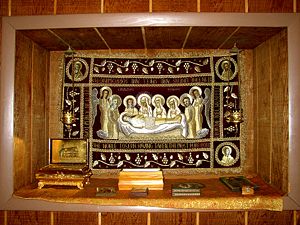Reliques : Différence entre versions
| Ligne 1 : | Ligne 1 : | ||
{{Traduire}} | {{Traduire}} | ||
{{Spiritualité}} | {{Spiritualité}} | ||
| − | Les '''reliques''' are portions of the earthly remains of Orthodox believers, usually [[saint]]s. Relics may also include clothing and [[vestments]] worn by saints, or items such as pieces of the [[True Cross]] | + | Les '''reliques''' are portions of the earthly remains of Orthodox believers, usually [[saint]]s. Relics may also include clothing and [[vestments]] worn by saints, or items such as pieces of the [[True Cross]]. |
| − | [[Image:Relics.jpg|thumb|300px|left|Différents reliques devant un [[epitaphion]].]] | + | ==Théologie== |
| − | + | [[Image:Relics.jpg|thumb|300px|left|Différents reliques devant un [[epitaphion]].]]Les reliques des saints sont [[vénération|vénérées]] parce que la foi orthodoxe croit que le corps reste temple de l'Esprit Saint même après la mort. | |
St. [[Cyrille de Jérusalem]] écrit: | St. [[Cyrille de Jérusalem]] écrit: | ||
| Ligne 12 : | Ligne 12 : | ||
[[God]] also performs [[miracle]]s through the holy relics of saints, in this way revealing his glory and glorifying his saints in whom he is pleased. One example is the relics of Saint [[Nectarios of Aegina|Nektarios]], which emitted a sweet-smelling sweat after he had passed away and showed no sign of decay until 20 years after his death. | [[God]] also performs [[miracle]]s through the holy relics of saints, in this way revealing his glory and glorifying his saints in whom he is pleased. One example is the relics of Saint [[Nectarios of Aegina|Nektarios]], which emitted a sweet-smelling sweat after he had passed away and showed no sign of decay until 20 years after his death. | ||
| − | + | ==Utilisation== | |
| + | Particles of relics of saints usually are embedded in [[altar]] tables during [[consecration of a church|consecration of church]]es. | ||
| + | |||
| + | Dans certains traditions, fragments de reliques se trouvent dans l'[[antimésion]]. | ||
| + | |||
| + | Certains chrétiens portaient autrefois des médaillions contenant des reliques. Aujourd'hui c'est surtout les évêques qui en portent, intégrées dans la crois pectorale épiscopale ou dans l'éngolpion. | ||
==Voir aussi== | ==Voir aussi== | ||
Version du 9 septembre 2008 à 22:12
| Cet article (ou bien des fragments) est proposé pour être traduit en français!
Si vous désirez assumer la traduction (partiellement ou intégralement), annoncez svp cela dans la page de discussions de l'article. |
| Cet article fait partie de la série Spiritualité Orthodoxe | |
| Saints Mystères | |
| Baptême - Chrismation Eucharistie - Confession Mariage - Ordination Sainte Onction | |
| Trois étapes | |
| Catharsis/Purification Theoria/Illumination Théosis/Divinisation | |
| Hésychasme | |
| Nepsis - Metanoia Hesychia - Phronema Mysticisme - Nous | |
| Ascéticisme | |
| La Chasteté - L'Obéissance La Stabilité - Le Jeûne La Pauvreté - Le Monachisme | |
| Vertus | |
| Humilité - Générosité Chasteté - Douceur Tempérance - Contentement Diligence | |
| Prière | |
| Culte - Vénération Règle de Prière - Prière de Jésus Reliques - Signe de la Croix | |
| Pères de l'Eglise | |
| Pères Apostoliques Pères du désert Cappadociens La Philocalie des Pères neptiques L'échelle sainte | |
| Modifier ce sommaire | |
Les reliques are portions of the earthly remains of Orthodox believers, usually saints. Relics may also include clothing and vestments worn by saints, or items such as pieces of the True Cross.
Sommaire
[masquer]Théologie

St. Cyrille de Jérusalem écrit:
"Though the soul is not present a power resides in the bodies of the saints because of the righteous soul which has for so many years dwelt in it, or used it as its minister."
God also performs miracles through the holy relics of saints, in this way revealing his glory and glorifying his saints in whom he is pleased. One example is the relics of Saint Nektarios, which emitted a sweet-smelling sweat after he had passed away and showed no sign of decay until 20 years after his death.
Utilisation
Particles of relics of saints usually are embedded in altar tables during consecration of churches.
Dans certains traditions, fragments de reliques se trouvent dans l'antimésion.
Certains chrétiens portaient autrefois des médaillions contenant des reliques. Aujourd'hui c'est surtout les évêques qui en portent, intégrées dans la crois pectorale épiscopale ou dans l'éngolpion.
Voir aussi
Liens externes
- Why Relics?
- The Place of Holy Relics in the Orthodox Church (or here) by St. Justin Popovich
- On the Veneration of the Holy Relics and Remains of the Saints by Archpriest Vasily Demidov
- Gleanings from Orthodox Christian Authors and the Holy Fathers
Images des reliques
- Holy Relics from Orthodox photos.com
- The relics of St. Innocent of Irkutsk, in the Znamensky Monastery Cathedral, Irkutsk, Siberia, Russia
D'autres lectures
- Holy Relics - A pamphlet by T. L. Frazier